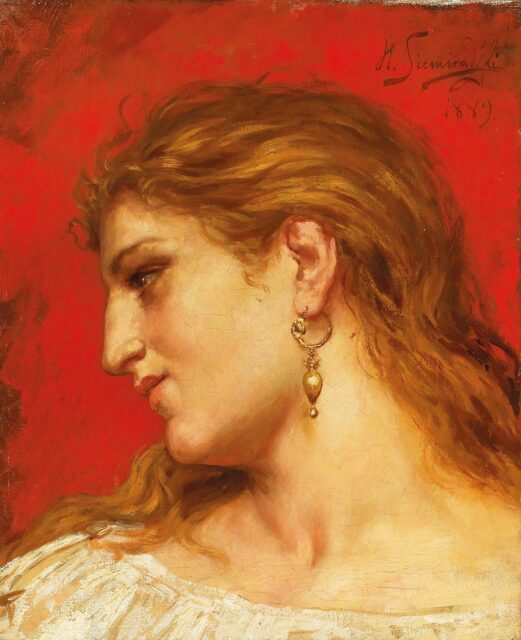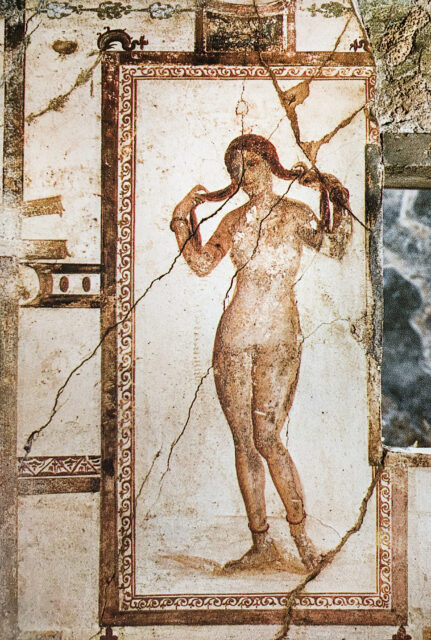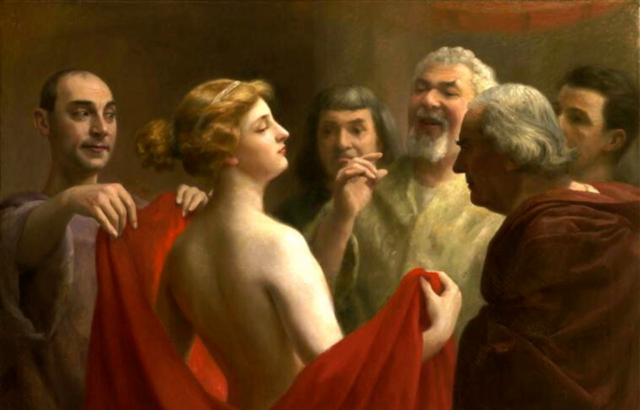Celebrated as a renowned courtesan and an object of desire, the ancient Greek prostitute Phryne was known for her magnetic charm and mesmerizing beauty. She enchanted some of the most powerful and artistic minds in her country. Yet she is arguably best known for the creative way she was acquitted during a trial for impiety. Discover this quick-witted beauty and the lasting legacy she left on the pages of history.
Early life
Although a well-known Greek figure, the story of Phryne is difficult to relay faithfully. There is a great deal known about her life, but many scholars question how reliable the information is. Nonetheless, there are certain facts, whether real or embellished, that are often included in her story. Supposedly, she was born as Mnesarete in Thespiae around the year 371 BC. She was called Phryne (Greek for ‘toad’) because she had a yellow complexion.

Despite where she was born, most of her life was spent in Athens. In her early years, she was extremely poor, but this would change as she eventually became one of the wealthiest Greek women. She was sold as a slave, often referred to as a prostitute, to the wealthy in Athens by the time she was 15. Phryne was said to have a beautiful face and body, and was determined to earn her freedom by using these assets. It was also how she came to be a muse for the famous Greek painter Apelles.
A true muse
A contemporary account from Athenaeus described her as “a really beautiful woman, even in those parts of her person which were not generally seen: on which account it was not easy to see her naked; for she used to wear a tunic which covered her whole person, and she never used the public baths. But on the solemn assembly of the Eleusinian festival, and on the feast of the Poseidonia, then she laid aside her garments in the sight of all the assembled Greeks and having undone her hair, she went to bathe in the sea.”

On one of these two occasions, Apelles was said to have watched Phryne walk nude into the sea with her hair trailing loose behind her. He was so inspired watching this that he asked her to be the model for his painting Aphrodite Rising From the Sea. He wasn’t the only artist inspired by Phryne. It is said that she was also the mistress of Praxiteles. He had her sit as his model while he created the sculpture Aphrodite of Knidos, one of the best-known and most widely recreated ancient Greek statues.
More than just a beauty
As much as it is the beauty of Phryne that is talked about, she was also incredibly intelligent and witty. One of the most famous accounts of this wit in action came following the destruction of the walls of Thebes by Alexander the Great in 336 BC. She said that she would pay to have them rebuilt with the condition that they were inscribed with the words, “destroyed by Alexander, restored by Phryne the courtesan.” Whether because of her societal status or her gender, her proposal was shot down.

In another clever move, Praxiteles offered to give her any of his statues. When she asked which was his favorite, he said he loved them all equally. Not long after, one of Phryne’s slaves arrived with news that the sculptor’s workshop was burning, prompting him to weep over losing two particular pieces – a satyr and a sculpture of Love. The clever courtesan revealed this was all a ruse and chose to take the latter statue for herself.
Phryne also unashamedly adored herself, allegedly dedicating a golden statue of her likeness, created by Praxiteles, in the sanctuary of Apollo at Delphi.
Trial for asebeia
Phryne’s wit and beauty are well documented, but it is her trial for asebeia for which she is undoubtedly best known. Asebeia is roughly synonymous with impiety or ungodliness. She was accused of three things: introducing a new god, leading a drunken ritual procession, and holding unlawful meetings in honor of Dyonisis.

The charges were brought forward by a man named Euthias, who happened to be one of her ex-lovers. Fortunately, a current lover, Hypereides, acted as her defense. Many historians believe that this trial actually had nothing to do with Phryne and was a way for Hypereides’ political enemies to get back at him. By all accounts, he spoke eloquently in her favor, even if most of his words were lost to time.
A victory for Phryne
What happened after testimonies were given varies greatly depending on the source, but one thing is consistent: Phryne’s breasts were shown to the jury, and she was acquitted of all charges. The first version of the story says that the courtesan decided to expose herself; the second version says that Hypereides exposed her as the climax of his speech; the third version says that he did so only when he realized that his words weren’t going to be enough to prove her innocence.

Regardless of who came up with the idea, in response to Phryne being exposed to the jury, Hypereides declared, “O respected judges; only the gods could sculpt such a perfect body. Killing her is a blatant disrespect to the gods. How can you condemn such a woman who is beautiful enough to stand in for Aphrodite herself?” No matter which way the jurors were convinced, they agreed with Hypereides.
More from us: Lucrezia Borgia Is Known as a Villainous Woman, but Are the Rumors True?
By this point in her life, Phryne was no longer an ideal age for a courtesan, but she was still well-beloved. It’s unknown when she died.
